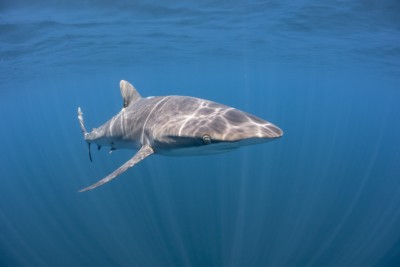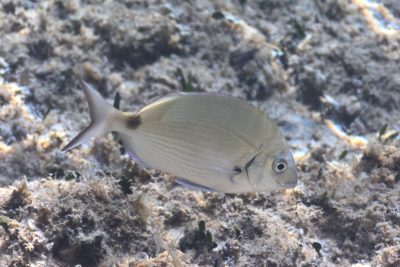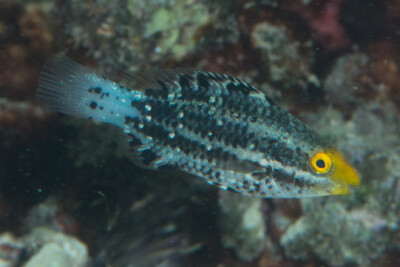parrotfish
| Scientific name | Sparisoma cretense |
|---|---|
| Descriptor | Linnaeus |
| Year of description | 1758 |
| IUCN category (World) | LC |
| Family | Scaridae |
| Genus | Sparisoma |


Introduction
The Mediterranean parrotfish Sparisoma cretense is one of the few representatives of the Scaridae family in temperate zones. It is native to the warm waters of the south and east Mediterranean, as well as the northwest African coasts. It is also found in the Azores, Madeira, the Canary Islands, and Cape Verde.
It was initially absent from the Spanish, Portuguese, and French coasts. On the Italian coast, until the 2000s, it was confined to the waters of Sicily.
Since the 1990s, this species seems to be benefiting from the warming of the Mediterranean waters to expand its distribution range. Young individuals have been observed on Gigio Island (Tuscan Archipelago, 1994), the Italian coasts of the Adriatic Sea (Apulia), and in Ria Formosa in southern Portugal. Scientists believe that these individuals come from the dispersal of eggs by currents.
However, there is no indication that these young individuals can survive the different winters. There are few observations of adults in these areas.
Who is it?
Morphology
-
Average size30 cm
-
Maximum size50 cm
-
Average size30 cm
-
Maximum size50 cm
How to recognize This fish ?
The Mediterranean parrotfish can grow up to 50 cm. Like its counterparts, the body is elongated and laterally compressed.
The dorsal fin has eight spines. The anal fin has three spines and nine soft rays.
Sexual dimorphism
The female is bright red, with two yellowish to grayish spots. One is located behind the eyes, the other is crescent-shaped and positioned at the base of the caudal fin.
Males are gray-brown with occasional grayish patches. Juveniles are also brown.
Behaviour & Life cycle
-
dietomnivorous with herbivorous tendency
-
Sociabilityliving in a group or alone
-
territorialYes
-
Way of livingdiurnal
These fish live in reefs. They sometimes frequent seagrass beds nearby. Adults mainly feed on algae they pick from rocks. They sometimes supplement this diet with aquatic microorganisms.
Males are territorial, with the larger ones occupying the best areas. They particularly favor exposed reef edges and deeper areas. These sites seem important for promoting reproduction as they allow for better egg dispersion during spawning.
During the first three years, growth is rapid and adult size is almost reached by the end of this period.
Reproduction
-
Reproductionovipare qui pond en eau libre
The Mediterranean parrotfish is an oviparous fish that spawns in open water. Females are mature in the first year, males in the third. In the Aegean Sea, reproduction occurs from July to September.
During the breeding season, two types of social structures are observed: territorial groups organized around a dominant male, accompanied by one to three females; non-territorial groups which can include up to fifty fish.
Spawning occurs in pairs for a brief moment, before dusk. It has only been observed among territorial groups. However, in the absence of organized gatherings outside the breeding season, it is possible that another mode of reproduction coexists. Additionally, females have an asynchronous ovary typical of species that reproduce multiple times during a breeding season.
Fertilized eggs are carried away by currents, and the larvae are pelagic.
Harmless species
This species does not represent any particular threats to humans when encountered in its natural environment.
Origin and distribution

Conservation status of populations (IUCN)
What is its habitat?
Natural environment characteristics
-
Temperature15 - 25 °C
-
Depth5 - 30 m
Biotope presentation
The Mediterranean parrotfish mainly inhabits rocky areas at depths less than 30 m.
Species of the same biotope
To go further
Sources & Contributions
Participation & Validation
The Fishipedia team and specialist contributors are committed to providing high-quality content. However, although the information comes from scientific sources or testimonials from specialists, the cards may contain inaccuracies.

Benoit Chartrer

Julie Magnus
Translation
Translation done with the valuable contribution of our translators, who make this information available to a wider audience. We sincerely thank them for their commitment.
Bibliographic references
First record of the Mediterranean parrotfish, Sparisoma cretense in Ria Formosa (south Portugal) - David Abecasis - Luís Bentes - Joaquim Ribeiro - Daniel Machado - Frederico Oliveira - Pedro Veiga - Jorge M.S. Gonçalves - Karim Erzini - JMBA2 - Biodiversity Records - 2005.
Occurrence of the Mediterranean parrotfish Sparisoma cretense(Perciformes: Scaridae) in south-eastern Apulia (south-east Italy) - Paolo Guidetti - Ferdinando Boero - Journal of the Marine Biological Association of the UK - 2001.
Social organization and sexual pattern in the Mediterranean parrotfish Sparisoma cretense (Teleostei: Scaridae) - M. de Girolamo - M. Scaggiante - M. B. Rasotto - Marine Biology - 1999.
Review of the Parrotfishes Family Scaridae - Leonard P. Schultz - United States National Museum - 1958.
Scientific partners
Tags
#Scaridae
#Sparisoma
#barrière de corail
#herbier
#zones d'algues et de détritus végétaux
#Mediterranean Sea
#Océan Atlantique Est Afrique - Golfe de guinée
#Temperate Eastern Atlantic Ocean
#Océan Atlantique Est Afrique - Transition & Cap Vert
#Eastern tropical Atlantic Ocean
#Canary Islands
#Sicily
Species of the same family
Species of the same biotope


























